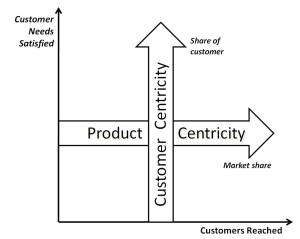 True customer centricity is still rare. This is news to me because these days you’re supposed to be customer centric. I hear many entrepreneurs describe their business as customer centric. Their product is customizable and totally flexible; they know their would-be customers thoroughly; their product utilizes big data to adapt to users’ needs; and so on…
True customer centricity is still rare. This is news to me because these days you’re supposed to be customer centric. I hear many entrepreneurs describe their business as customer centric. Their product is customizable and totally flexible; they know their would-be customers thoroughly; their product utilizes big data to adapt to users’ needs; and so on…
More often than not they are product centric. Examples:
- I like to surf and ride a motorcycle (not at the same time). I can attach my GoPro to a surf board or my helmet. But GoPro is not customer centric, it’s a superior product.
- My broadband went dead after a power failure. I called my provider and they quickly decided to send me a new ADSL box. No hassle, happy customer. But this is not customer centricity, it’s operational excellence.
Both cases are good customer service, but it’s the same for every customer. Customer centricity requires a step further. You need to know your customer, the lifetime value of each customer, when and what to offer to the customer to add the most value, etc. If you’re customer centric, you don’t offer the same product/service for any two customers. Instead you proactively tailor your offering to cater individual customer’s needs.
The most well-known examples of customer centricity come from retail. See How Target Figured Out A Teen Girl Was Pregnant Before Her Father Did:
… Which means that the key is to reach them earlier, before any other retailers know a baby is on the way. Specifically, the marketers said they wanted to send specially designed ads to women in their second trimester, which is…
Another case is how Tesco manages to maintain high growth and ward off competitors like Walmart. In a story by Businessweek:
Tesco’s big advantage over major international rivals, which also include Germany’s Aldi and Lidl, is its unrivaled ability to manage vast reams of data and translate that knowledge into sales. While data crunching may sound dull, it has given Tesco two major advantages: an unmatched ability to operate multiple retail formats—ranging in size from convenience stores to hypermarkets—and the market knowledge to offer what many analysts say is the best and broadest range of house brands from any retailer.
Now that’s customer centricity.
Why would you want to be customer centric?
Because the world has changed. The power has shifted from producers to customers. Consider:
- Product development is much faster. Earlier it took a lot of effort to create a new product. Now technology enables anyone the create a product even if the scale would be very small. Think Kickstarter.
- Information flows much faster. It used to be impossible or very expensive to reach a big audience. Now anyone can publish a video, article, or create a social media campaign.
- Global delivery knows no borders. You just couldn’t order goods from other countries. Now anyone can go to Amazon or Alibaba.com and order anything, delivered anywhere.
There used to be a barrier of entry. Even if someone could develop a similar product, there was no way they could market it to your customers. And even if they found a way to market the similar product, there was no way they could get it delivered. Not so anymore.
Nowadays customer centricity is the way to maintain your competitive advantage.